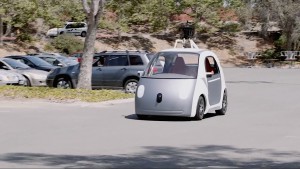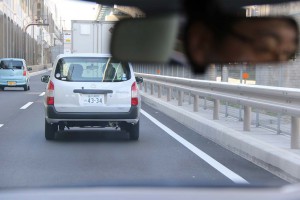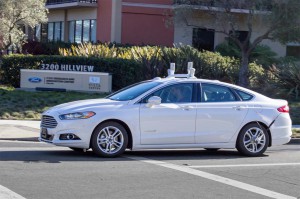California regulators have laid out new rules covering the imminent roll out of autonomous vehicles and, among other things, they’ve decided that “driverless” cars will continue to need to have a driver – or at least a licensed “operator” — sitting behind the wheel.
California already has a large number of autonomous prototypes rolling down its highways, and Google, considered one of the leaders in self-driving technology, operates many of them near its base in Silicon Valley. But the new rules show regulators want to take a go-slow approach to actually putting autonomous vehicles in the hands of consumers.
The draft regulations are generating a mixed response; some skeptics see the move as a way to put safety first, but Google said it was “gravely disappointed” by the state’s announcement.
California is one of a handful of states – a list that also includes Nevada, Florida and Michigan – with specific rules covering the testing of autonomous technology. But the Golden State’s Department of Motor Vehicles has now laid out plans for transitioning from research to retail.
Tesla recently introduced the first semi-autonomous system available to the public, its AutoPilot allowing motorists to drive hands-free on well-marked, limited-access highways. Mercedes-Benz, BMW, Cadillac and Nissan are all expected to follow. And Nissan has said it plans to launch its first fully autonomous model, capable of driving on all roads, in 2020.
A study released this month by Britain’s Juniper Research forecast nearly 20 million self-driving vehicles will be in use around the world by 2025.
(For more on the Juniper autonomous vehicle study, Click Here.)
Skeptics like Washington-based safety advocate Joan Claybrook, a former head of the National Highway Traffic Safety Administration, have questioned whether the industry is moving too quickly. The California DMV rules seem to take a middle ground.
Key elements of the proposal include:
- A requirement that a licensed “operator” must remain behind the wheel – and that they must be trained to understand how to react in case the vehicle’s sensors, computer and controls fail;
- Owners would have to agree to let carmakers collect data on the operation of the vehicle;
- Manufacturers will need to beef up cyber-security to protect their vehicle against hackers;
- Automakers also would have to certify the “ability (of an autonomous vehicle) to perform key driving maneuvers that are typically encountered in real-world driving conditions.”
The draft regulations also will, for the foreseeable future, continue to require vehicles to be equipped with conventional controls, including a steering wheel, throttle and brake pedals. That’s a setback to the plans laid out by Google, which the Juniper study declared the leader in self-driving technology.
The Silicon Valley tech giant is in the midst of rolling out a fleet of 100 so-called “Google Cars,” specially designed prototypes being used for testing near corporate offices in California and Texas. While the first of these are equipped with standard controls, Google had planned to leave them out of later versions. Riders would use voice commands to set a destination and would only have a shut-off button to use in an emergency.
“We’re gravely disappointed that California is already writing a ceiling on the potential for fully self-driving cars to help all of us who live here,” wrote Google spokesman Johnny Luu, in a statement.
Luu noted that 94% of all accidents are currently blamed on human error, not faulty equipment, and he said the new California rules could limit the ability of autonomous vehicles to serve those whose movements are already restricted – such as the aged or physically handicapped.
(Samsung is the latest tech giant to enter autonomous vehicle race. Click Here for more.)
But others were pleased by the proposal, John Simpson, privacy project director at Consumer Watchdog, saying regulators, “did exactly what they should do, which is put the public safety first — and then take steps that promote the technology in a safe way.”
While more than a dozen different automakers have publicly discussed their autonomous research programs, Google has become the lightning rod for the technology. And critics point to the 16 known collisions involving the company’s autonomous prototypes as reason for concern.
From a legal standpoint, the other driver has been declared at fault in each of those accidents. But skeptics say the Google prototypes at least contributed to a number of those incidents by responding over-aggressively when, for one thing, a stoplight changed from green to yellow. Google itself has said it needs to update its software to take into account the way human drivers respond to routine roadway situations.
Despite the concerns raised by Google, observers don’t expect the new California regulations to be much, if any, of a setback to self-driving vehicle development. The timetables laid out by most manufacturers are unlikely to shift, meaning California could be ready to license its first autonomous vehicle operators by the end of the decade.
(Ford launches autonomous vehicle testing in California. Click Here for the story.)




It’s about time that government agencies wake up and set some guidelines before the rush-to-market mentality kills people. The Feds have an obligation to create and publish mandatory AV safety, design, manufacture and maintenance regulations NOW, before the rush-to-market crap endangers naïve consumers.
Instead of being proactive and protecting the public now, in typical governmental practice, we will see a knee-jerk reaction once people start getting killed in AVs. Then it will be too late and all will ask how it was possible for these AV builders to escape all accountability for hack free, failsafe designed AVs with redundant controls and proper limp modes to get them off the roadways when they have a computer crash or worse.